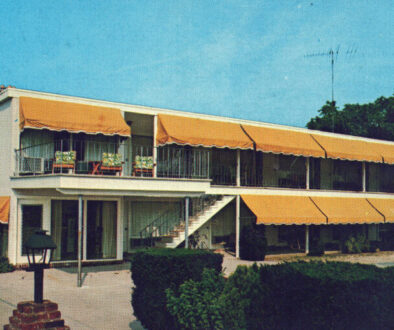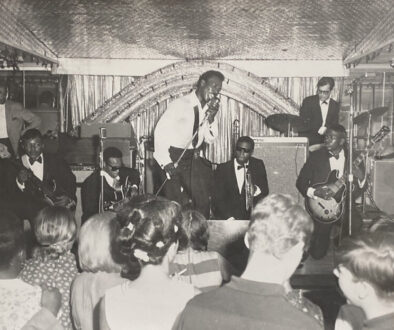Harriet Tubman’s Cape May Connection
“She came to Philadelphia, and worked in hotels, in club houses, and afterwards at Cape May. Whenever she had raised money enough to pay expenses, she would make her way back, hide herself, and in various ways give notice to those who were ready to strike for freedom.”
The Treasury Department’s recent announcement that freedom fighter Harriet Tubman will replace President and slaveholder Andrew Jackson on the face of the $20 bill finally acknowledges Tubman’s place in the pantheon of American heroes.

Most school children learn that Tubman, born a slave, freed herself and then risked her life time and again to return to the South to emancipate family and friends. But few people know the role that Cape May played in her efforts. It was here in Cape May that Tubman earned some of the money critical to carry out her rescues.
Tubman was enslaved on the Eastern Shore of Maryland, which sits across the Delaware Bay from Cape May. At the time, the Eastern Shore was an agricultural area and a source of prized lumber for the Baltimore and New England shipyards. These goods were transported on the numerous waterways and canals in the region.
Life was harsh for Harriet Tubman during the 27 years she was enslaved to a small planter who mostly hired her out to other farmers, many of whom beat her severely. Tubman worked alongside her oxen, plowing fields, lugging huge barrels to ships, pulling boats through the canals.
She also worked deep in the forests on a timber gang, felling trees. Then she hauled the logs to the waterways and boats that carried the timber to the Baltimore shipyards. The work was backbreaking and exhausting. But it created a close-knit community of people, both slaves and free blacks, who knew the forests, the waterways and each other. It was this network of people that helped Tubman when she later returned to the area to free her family, according to Kate Larson’s definitive biography of Tubman, Bound for the Promised Land.
Her parents, who had nine children, were separated on different plantations not long after she was born in 1822. She heard stories of siblings sold away before her birth and she watched in horror as two older sisters, weeping bitterly, were hauled off in a chain gang to a buyer in the South, leaving at least one child and husband behind. The slaveholder, Edward Brodess, had sold them to buy more land.
While her family lived in constant fear of more sales during Brodess’s lifetime, it was actually after his death in 1849 that their situation became dire. It was then that his widow started selling off slaves to pay her extensive debts. Rumors surfaced that year that Harriet was soon to be sold. She decided to leave, despite the reluctance of her husband, John Tubman, a free man, to leave with her. Using her connections in the white and black communities, she made her way to Philadelphia.
Almost as soon as she got there she realized that freedom was not enough, she needed her family to share it with her. That’s when she determined to rescue them all, as she told her friend Sarah H. Bradford, who published a biography on Tubman in 1869. “I had crossed the line. I was free; but there was no one to welcome me to the land of freedom. I was a stranger in a strange land; and my home, after all, was down in Maryland; because my father, my mother, my brothers, and sisters, and friends were there. But I was free, and they should be free.”
So she found jobs as a domestic and as a cook to support herself and finance rescue trips to the Eastern Shore. Bradford wrote, “She came to Philadelphia, and worked in hotels, in club houses, and afterwards at Cape May. Whenever she had raised money enough to pay expenses, she would make her way back, hide herself, and in various ways give notice to those who were ready to strike for freedom.”
Her first rescue came in December 1850, when she received word that her niece, Kessiah Bowley, and two small children were to be sold in the Deep South. Tubman worked out a plan with Kessiah’s husband John Bowley for a daring rescue in Baltimore, when she and her children were literally on the auction block. Tubman hid them until she could safely move them to Philadelphia. A few months later Tubman returned to Baltimore to lead her brother Moses and two others to Philadelphia.

That year marked the start of the worst period in pre-Civil War history for people of color. It was a time when no black person in the North, neither those who had fled slavery nor those born free, was truly safe from the tentacles of slavery.
In 1850 Congress passed the Fugitive Slave Act, which allowed slave holders to act with impunity in tracking down anyone who escaped captivity. It overrode laws many northern states had enacted to hinder the capture of people fleeing slavery. Federal officials could now brand someone an escapee on little more than the word of a slaveholder and force local officials to imprison them. Ordinary citizens could be compelled to help round up people or face fines and jail.
Thousands of blacks, even those who had been born free in the north, fled to Canada, a British territory that banned slavery and was beyond the reach of slave catchers. Among those who fled to Canada were Harriet Tubman’s niece Kessiah, her husband and infant daughter.
Harriet Tubman instead travelled in the opposite direction, returning to the Eastern Shore in December 1851 to lead to freedom a party of 11 people, which may have included a brother and his wife. She brought them to Philadelphia, then continued with them through New York State and across the bridge to Canada. Tubman kept house for them while working and arranging help from friends and local aid societies. It was a brutal winter, and for the people who had arrived from the more temperate climate of the Maryland shore, particularly difficult. Earning money by chopping wood in the frozen Canadian forests, they were plagued by frostbite on their toes and fingers. Often they went hungry. But they made it through their first Canadian winter.
Tubman, however, was determined to return yet again to the Eastern Shore for the rest of her family. But she needed money to be able to do that. So when the weather got milder she went back to Philadelphia and Cape May, where she knew she could get work. “In the spring she returned to the States, and as usual earned money by working in hotels and families as a cook,” another friend of Tubman’s, abolitionist Franklin F. Sanborn, wrote in the Boston newspaper Commonwealth in 1863.
And then he noted it was from Cape May, where she was working, that Tubman returned to the Eastern Shore. “From Cape May, in the fall of 1852, she went back once more to Maryland, and brought away nine more fugitives.”
A similar account was written in an unpublished manuscript by Emma Telford, another friend who spent hours visiting Tubman in Auburn, New York, after the Civil War. “With the advent of spring she again returned to the states, earning money by working as a cook at Cape May.”
At least 13 times Tubman returned to the Eastern Shore, the land she called Egypt, perhaps from Cape May, often from Philadelphia or upstate New York. Over the years she directly led at least 70 people to freedom, according to Larson. She gave another 50 or more instructions that allowed them to find their own way north. Not surprisingly, freedom seekers called her Moses.
How many summers she worked in Cape May is not clear. The New Jersey Historical Commission’s book about the Underground Railroad in New Jersey, written under the direction of the eminent historian Giles Wright, says that she was here in the summers of 1850 to 1852.

Cape May was a good place for Tubman to work. She could get here easily via daily steamship service from Philadelphia, where she often stayed. And she could get over to the Eastern Shore, most likely with help from the free black community here, many of whom worked on the water.
There is no definitive information on where she worked in town, but there were a number of large hotels operating in 1850. Their staffs were mostly people of color, which would have made it easy for her to escape notice. These hotels included Congress Hall, the Atlantic Hotel, Ocean House and Centre House, all of which were adjacent to one another near the beach. Only Congress Hall, rebuilt after the disastrous 1878 fire, remains today.
Cape May was a meeting point of the North and South in 1850. Philadelphia abolitionists, eager to get away from the city’s disease and filth, took the daily steamer or twice-weekly stagecoach. At the same time Southern plantation owners, from Baltimore and Norfolk, who also had handy access to Cape May via ship, were eager for relief from the heat and humidity at home. Often they brought their slaves.
At times this mix exploded. Swedish novelist Fredrika Bremer, a friend of Hans Christian Andersen, visited Cape May on a U.S. tour in 1850. She described the tensions: “We have had a great battle in one hotel between the black servants and the white gentleman, which has caused some bloody heads,” she wrote. “The greatest share of blame falls upon a gentleman who owns slaves. He will be obliged to leave.”
Tubman’s role as a freedom fighter and humanitarian took on a different form when the Civil War began. She continued to speak out at anti-slavery rallies and lectures. But she also aided the Union forces.
She went to South Carolina to help provide food and services to the massive number of slaves coming to areas held by Union troops. She helped recruit blacks for the Union army. She helped nurse Union soldiers sick with dysentery.
She went behind Confederate military lines to ferret out information on rebel strategy and strength. Tubman was the first woman to execute a military raid, directing federal gunboats up heavily mined waters to raid a Confederate storehouse.
After the war, despite a constant struggle to earn money to support her family members, she found time to speak widely in support of women’s suffrage. She also helped build a home for aged African Americans.
Connections between Tubman and Cape May continue to this day, according to research unearthed by the Cape May Center for Community Arts. After the Civil War, Harriet Tubman’s niece, Kessiah Bowley, who she rescued in Baltimore, returned to the Eastern Shore of Maryland with her husband and daughter. Kessiah’s great granddaughter, Florence Cooper, settled and raised her family here in the Cape May area. Florence Cooper is buried in Mt. Zion Cemetery on Shunpike Road.
ETA 11/5/19 – The Harriet Tubman Museum of Cape May is planned to open in the Parsonage adjacent to the Macedonia Baptist Church. It is scheduled to open in 2020. Find out more on their Facebook page.



